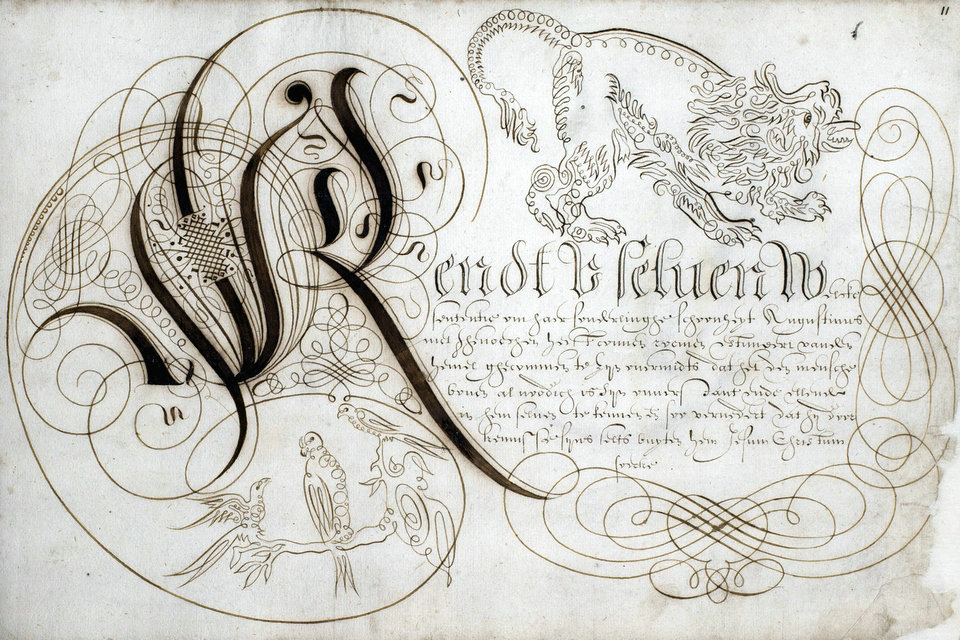

Lineography is one of the techniques of calligraphy, the art of drawing without lifting the pen, pencil, or paintbrush that is being used. Originally from the xv th century, calligraphers or writing masters became accustomed to decorate their pages copied with ornaments called gifts, kinds of paths cross without lifting the pen.
The practice originated in France in the seventeenth century. It fell into disuse by the early nineteenth century. Lineography experienced a resurgence in 1960 with the release of the Etch A Sketch.
Cadellés letters
The cadelée letter is a drop cap large ornate tracery full feather strokes and thin strokes, often forming diamonds games. It appears in the French manuscripts from the xv th century, especially in the stately burrows. There are many examples of these gift letters in the Gothic Alphabet of Mary of Burgundy, made around 1480, probably by the calligrapher Clas Spierinck and kept today in the Louvre.
Very quickly, the cadelée letter passed in the printing press at the end of the century, at the time when the printed book wanted to imitate the manuscript.
Pen line drawings
Once this technique was well acquired and disseminated, some made more elaborate drawings, representing characters, animals, entire scenes sometimes copied from engravings of the time. Among the most skillful in this kind, there is the xvii th century Jean de Beaugrand or Balderic van Hořické and xviii th century Peter John Paul Berny Nogent.
The technique of the stroke of the pen is perpetuated long enough during the xix th century for ornamental title pages of musical editions. It is also found examples in typographic ornamentation, and incidentally for some artists of xx th century (Picasso, Valentine Hugo, Jean Cocteau. The study by Jérôme Peignot is the only one that has this technique in its continuity until xx th century.
Example
In some instances, entire landscapes and still lifes have been drawn or painted using this lineographic technique. Famous works of art, such as the Mona Lisa, have been reproduced using the Etch A Sketch. The television show How It’s Made used Lineography in the short segments at the beginnings of many episodes giving a summary of the history of the episode’s subject.
Pen-line portraits
Writers masters and French calligraphers of xviii th century began under the reign of Louis XV, to make portraits in pen stroke and freehand:
Claude Antoine Druon Rochon: portraits of Louis XV, Louis XVI.
Jean-Joseph Bernard: portraits of Louis XVI and Marie-Antoinette; numerous portraits of elegant women who “went to have them written in profile by a show of hands” (Abrégé du journal de Paris, 1789); portrait of Napoleon.
M me Dabos (Marie Jeanne Bernard, daughter of Bernard): portrait of Marie-Antoinette.
Mademoiselle Bernard, niece of Bernard: “in 1816, she executed Louis XVIII in a single stroke, by a show of hands” (Carteret, p. 320).
Baudran: portrait of Marie-Antoinette.
Georges Philippe Jumel, master writer from Caen: in 1777, painted the portrait of Marie-Antoinette in one stroke, by show of hands. “This portrait, a calligraphic tour de force, represents the bust of the queen turned to the left and engraved with a single stroke of the pen continued by the circular ornament which serves as a frame” (Iconographie de la reine Marie Antoinette, Paris, 1883).
Bernard Jauffret, painted with the stroke of a pen, by a show of hands, the portrait of the same queen (1788); this portrait was engraved by Petit (Luneau de Boisjermain, Cours de bibliographie, 1788, p. 92).
Pierre-Jean-Paul Berny de Nogent, various portraits of Marie-Antoinette, Louis XVI, etc.
Bariolle: portrait of Louis XVI, engraved by Aubin.
Étienne Guillaume-Montfort: made the portrait of Bonaparte with a show of hands.
Auvrest: portraits of Sully, Henri IV, Louis XV, Louis XVI, Napoleon and others.